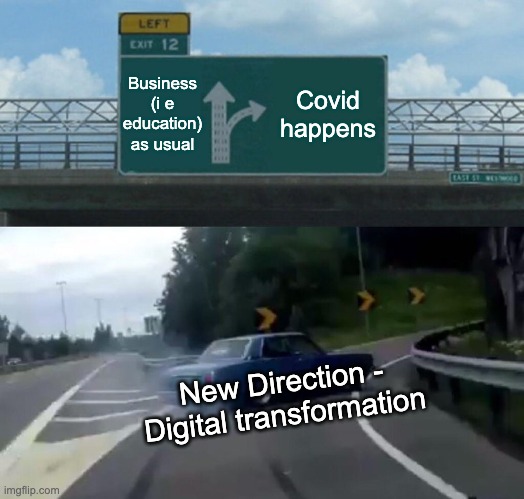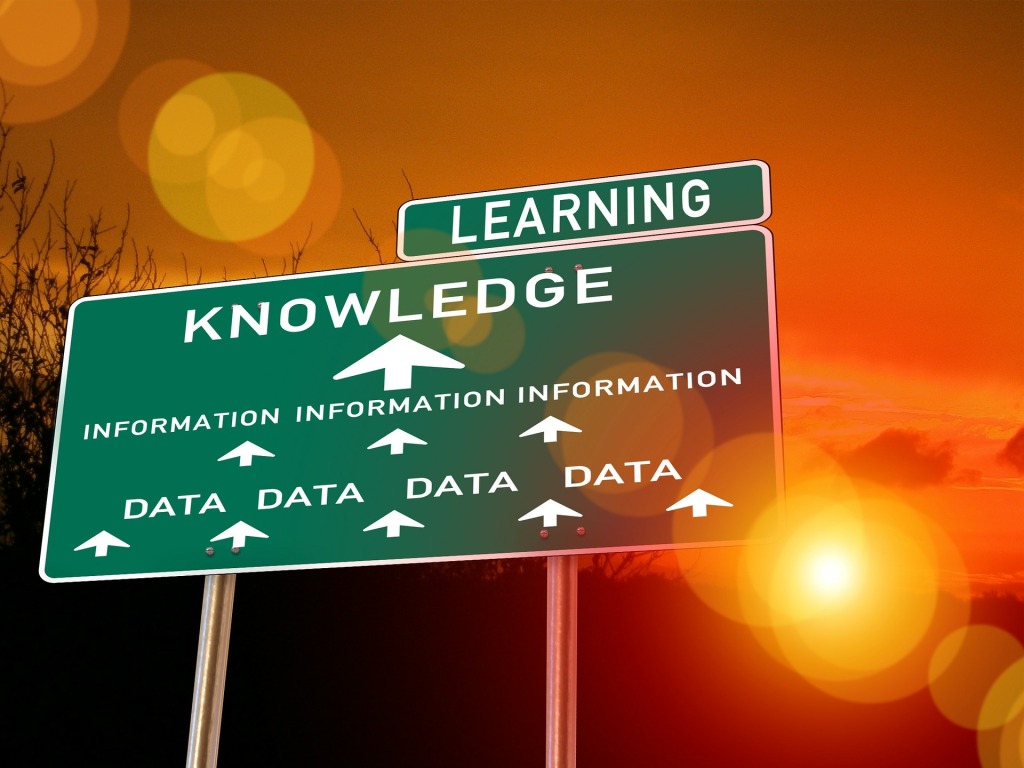In this last blog post I will summarize my main take-aways from the ONL course and also reflect about future steps. Let me start by a meme although this picture doesn’t show the whole truth about reasons for converting to online or distance courses with blended learning (for other reasons see my last blog post).

Main take-aways for digital transformation
The course started with two weeks focusing on getting started and getting to know each other – a design in accordance with the frameworks of Communities of Practices (Lave & Wenger, 1991; Wenger, 1998), Learning Communities (West & Williams, 2018) and Communities of Inquiry (Garrison, Anderson & Archer, 2000; Vaughan, Cleveland-Innes & Garrison, 2013). During these two weeks, aspects such as access and relationships, a kind of engagement with participants for building a sense of fellowship and community were in focus. We also tried to get a grip on, engage with the vision and function of working in a community, as well as to develop a common ground for our collaboration.
During next two weeks we started to engage with the content and the goals of Online participation and digital literacies, as well as deepening our relationships in terms of social and cognitive presence. At this stage we were insecure about how to work in the PBL-group, and about the expectations of the end product. Afterwards we could see that this two weeks set the routines for our group although we tried to break out once or twice. Having facilitators present as well was a security, still I believe this is really difficult to manage within an ordinary course as Bates (2019) says when discussing teachers’ roles as facilitators as crucial in online learning: “There are though some limitations … it does not scale easily, requiring highly knowledgeable and skilled instructors, and a limited number of learners per instructor”. (chapter 4). To be inspired to reflect on, and analyze, your own engagement in digital environments as a professional and on a personal level, in terms of being a visitor or an inhabitant (see White, 2014; White & Le Cornu, 2011) was a really good start to the course. The eight guiding principles of digital literacies pointed out by Dough Belshaw in his ted-talk made me reflect upon both my skills and lack of skills but also about my digital identity, both as consumer and/or producer, but also about my profile, what I want to be visible or not, which thus connects to topic 2, Open learning-Sharing and Openess.
This was a topic that I found a bit hard to engage in as it was both complex and at the same time wide. I believe getting to know the rules of Creative Commons is my top take away which I have lent on in my use and re-use of pictures since then.
The third and fourth topic about Learning in communities- networked collaborative learning and Design for online and blended learning became very intertwined for me. My learning style is to follow threads, trying to get a grip on theories and concepts (which were part of both topics) and then put them in relation to each other and my previous knowledge in order to create some sense out of it. I then need to conclude the implications before going into how to use them. I therefore worked somewhat simultaneously with these two topics.
As the process went further, we became more and more open and our emotional presence became more visible as we had got to know each other better. We started to share narratives and experiences in a higher degree and had some good laughers. When having lived the process, or as we concluded in one of the memes we created, built the railway while running the train, we could relate the theories and content to our own process although it felt a bit messy sometimes (like one of the other Memes with a roundabout built as a square) – see our SWAY with the Memes here.
Since I got sick one week, I really didn’t have the time to sort things out as much as I would have liked, and that would have been great as I usually end up with a lot of readings and new knowledge that I find interesting and fruitful. I am blessed with a curious mind a motor that drives me to understand. When writing the blog post for topic 3 and 4 I felt like the students who use to have difficulties in killing their darlings as they want to show everything they learnt in their exams. But, in this course I was a student so I forgive myself – I have learnt a lot although my blog posts are a bit unsorted.
 Picure by Geralt, Pixabay.
Picure by Geralt, Pixabay.
At the same time, I think all the content that I wanted to understand and the different perspectives that the references contributed with, will be important for me as an educational leader in the future – which leads me to the next heading in the blog post.
Future steps
As I work mainly as an educational leader in our teacher education program for early childhood education and care teachers my role will be to inspire and support the teachers working in the program in their re-design. We have recently had a workshop about online tools with our university’s instructional designers. My colleagues haven’t had the opportunity to attended the ONL-course and as it requires quite a lot of time and engagement I think I will have to share my new knowledge and reflections with them both spontaneously and contnously but also in an organized way. I have therefore started to write an application for funding to be able to work in our team with developing our program and courses. I am really looking forward to that! I think it is important to not focus only on design or technology, but also going back to our scientifically grounded views about learning and knowledge, creating our vision on that and design towards that. While we live our utopia it becomes true. As we all are in the sbject of education we have a lot of knowledge in that area, but maybe have to update ourselves with theories about online and blended learning as our reality today looks different from yesterday.
I usually use the metaphore of the GPS when talking to the teacher students about the importance of being knowledgeable about theories of learning and to continuously update those. For me theories are likae maps, that help you to orientate and choose direction. You need to update your GPS in order to be able to drive safe and responsible (in relation to your mission). I mean, trying to drive in a foreign country with signs in a language you maybe have difficulties to understand (and maybe also with a car for left-hand driving in a left-hand traffic country) is difficult enough with an updated GPS. I can hear the voice: “Take the third exit in the roundabout” and still I can’t see three exits, and start sweating by stress.

The one of you that have read my earlier blogs know that this doesn’t mean that we uncompromising shall drive on main streets or follow the map in every situation. I believe that what good teachers are best at are having a well developed sense of feeling for when and how to improvise, change, make use of experience and go by the flow. On unknown routes.
I will end this blog-post with one of my favourite citation from unknown:
“Experience, knowledge and wisdom – to guide you in thought and deed”
and with a celebration to this course and my PBL-group and myself for finalizing it (click the picture below for seeing the action (animation). And if you wonder how far we can go – What do you recon? No limits of course!

Thank you for reading! / Susanne
References:
Bates, T. (2019). Teaching in a Digital Age: Guidelines for Teaching and Learning. (2nd edition). Available at: https://pressbooks.bccampus.ca/teachinginadigitalagev2/
Belshaw, Dough (2012). The essential elements of digital literacies: Doug Belshaw at TEDxWarwick, https://www.youtube.com/watch?v=A8yQPoTcZ78
Creative Commons [website] available at: https://creativecommons.org/licenses/by-nc-nd/2.0/
Lave, J. & Wenger (1991). Situated learning: Legitimate Peripheral Participation. Cambridge: Cambridge University Press. ISBN 978-0-521-42374-8
Vaughan, Cleveland-Innes & Garrison (2013) Teaching in blended learning environments: Creating and sustaining communities of inquiry. Edmonton: AU Press.
West, R. E. & Williams, G. (2018). I don’t think that word means what you think it means: A proposed framework for defining learning communities. Educational Technology Research and Development. Available online at https://edtechbooks.org/lidtfoundations/learning_communities
Wenger, E. (1998). Communities of practices. Learning, meaning and identity. Cambridge: Cambridge University Press. ISBN 978-0-521-66363-2.
White, D. (2014). Visitors and residents.
White, D., & Le Cornu, A. (2011). Visitors and residents: a new typology for online engagement, Fi®st moñd@y, Peer-reviewed journal on the internet.
https://firstmonday.org/ojs/index.php/fm/article/view/3171/3049